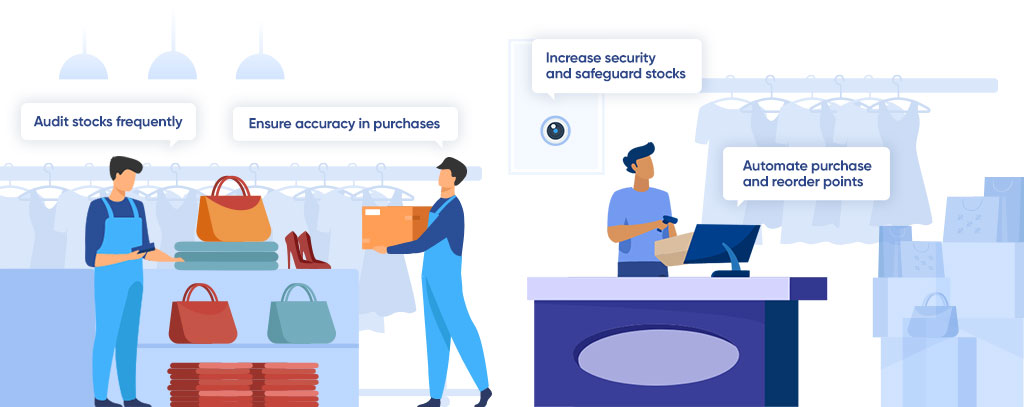
Dip, dip, dip! Have you heard this sound from a leaky tap sometime? You would have definitely tried to close it tight to stop the water from wasting, isn’t it? I, too, did the same, but the water kept dipping slowly. The next day, the same tap had a bucket kept below, and I was shocked to see collected water flowing out. I realized that even if the drops were slow, if left unnoticed the impact would be huge. That’s when I remembered a famous story where a small dutch boy puts his finger in the dike. Yes! When he spots a crack in the dam, he decides to put his finger in the hole immediately so that the crack doesn’t grow big, make the dam break and put the people’s lives at risk. ‘Inventory shrinkage’ has no major difference; if left unnoticed, it might risk your business to an extent of sinking it down!
When you have excess inventory in your records but do not have them in your actual inventory, it causes a shrinkage. Wish to know what is shrinkage to plug the leak in your inventory? Instead of putting your finger in the dike every time, let’s see how to bring a permanent fix to your inventory before shrinkage becomes unstoppable!
What is Inventory shrinkage in retail?
The loss of products in inventory because of unforeseen circumstances like supplier fraud, theft, shoplifting, damage, etc., is called ‘Inventory shrinkage’. For example, Brjo Footwears had 2546 pairs of sandals and shoes, but upon a stock count, they found only 2120 pairs actually present in the store. This loss is referred to as ‘Inventory shrinkage’, and it is highly important to take immediate steps for retail loss prevention. We know what is Inventory shrinkage. Now, it’s time to know how it can affect your business.
How will shrinkage affect your business when it’s left unnoticed?
The inventory of any business consumes the major part of the working capital. Simply put, inventory is the money stored in the racks and shelves and across the warehouse. When the inventory shrinks, then there is a direct impact on cash blockage and a big hit in the profits. Let’s understand the serious threats a business faces when the shrinkage is unaddressed.
- Lessen profit levels
- Loss of inventory
- Affects accounting
- Poor shopping experience
- Drains money invested
So, next coming to your business. Are you aware of the Inventory shrinkage rate in your business? Let’s find out!
How to calculate Inventory shrinkage?
To know what is shrinkage in retail, the Inventory Shrinkage Rate (ISR) lets you know the percentage of inventory value to shrinkage.
Inventory shrinkage formula:

Inventory Shrinkage Rate = Inventory Shrinkage * 100
Here,
Recorded Inventory = Inventory – Cost of Goods Sold (COGS)
Example of shrinkage in retail,
Deva, who owns a retail store, wishes to calculate the shrinkage in his business. The store has a total inventory value of 10,00,000 Rs, and the Cost of Goods Sold for the accounting period of one year is 1,50,000 Rs.
Now, the Recorded Inventory = 10,00,000 – 1,50,000 = 8,50,000 Rs
Deva has calculated the ‘Actual Inventory’ value as 7,50,000 Rs based on the stock audit done. The difference between the actual inventory and the original inventory shows that there is shrinkage. Now, let’s calculate the shrinkage using the formula.
Inventory shrinkage = 8,50,000 – 7,50,000 / 7,50,000 = 0.13
Inventory Shrinkage Rate = 0.13 * 100
ISR = 13.33%
This means that Deva has lost 13.33% of his inventory to shrinkage, due to various reasons! The acceptable Inventory shrinkage percentage is 1% and if the ISR is above 1% it has to be given immediate attention.
To reduce the ISR, firstly one should identify the reasons for facing shrinkage in Retail business.
Causes of Inventory shrinkage
Just like how a tap can be leaky due to worn-out seals, water pressure, broken parts, corroded valves, etc., there are different reasons that contribute to Inventory shrinkage. A few top reasons include,
- Shoplifting
- Theft
- Excessive product supply from supplier
- Product damage/expiry
- Administrative errors
The above reasons contribute to the different types shrinkage in Retail, and those might not be directly in control of the store. However, there are some tactics that can be put into practice to prevent Inventory shrinkage permanently! All it requires is consistent efforts in enhancing safety, employee engagement, and security with the help of a good inventory system, just like having a high-quality standard tap to be leak free!
How to identify shrinkage in retail?
Just like how the little boy found the crack in the dam and reacted to it immediately, it is important to identify and react quickly to save the business from inventory shrinkage.
Having a robust inventory solution helps you identify retail shrinkage, lets you to keep a track of your inventory and increases visibility over all products in one place.
So, how can an inventory solution help in identifying inventory shrinkage?
The first step towards identifying inventory shrinkage is conducting a ‘stock audit’ of your business. Only if you know your actual inventory value can you measure the discrepancies and calculate your Inventory shrinkage and fix the cash shrinkage the business faces.
Running perpetual stock audits in your business helps you spot the variance and identify the reasons for shrinkage as well. Few critical challenges that prevent a retailer from doing frequent audits is not having a proper tool to audit, the need to close the store, and coping with manual errors during reconciliation. However, when you have a stock audit tool like GoSure, stock counting during business hours becomes perfectly possible! Perpetual audits can be done with peace by planning for audits during daily employee lean hours seamlessly. You can identify and correct the discrepancies all in a single click. From knowing the actual inventory available for sale to the expired, damaged and missing stocks, all can be counted at once and corrected with the help of GoSure. There are chances of some stocks getting missed due to damage, but unethical reasons like theft and supplier fraud are serious offenses to be paid attention to with priority. A stock audit helps you find the root and gives clarity on how to control shrinkage in Retail business.
How to control Inventory shrinkage with these 4 simple steps?

1. Audit stocks frequently
Every time you count your stocks, you get a chance to detect discrepancies. And this is the only way to know the rate of Inventory shrinkage in your store. Performing stock audits daily is exceptional, weekly is optimal, and once a month is normal. However, when you go beyond that, it will be hard to bring the shrinkage under control. So, plan for perpetual audits whenever you can!
2. Ensure accuracy in purchases
Supplier fraud is one common problem that adds to the ISR. Having a track-back purchase management solution that ensures transparency across transactions helps you spot errors at the receiving end and helps in 100% accurate inwards. Never let your suppliers take advantage of shorting the quantity delivered when you have an automated tool to guarantee accurate inwards from anywhere!
3. Increase security and safeguard stocks
Strengthening the levels of security will definitely put a stop to unethical theft and shoplifting activities happening in and around the store. Upgrading video security systems, and checkout processes will help in controlling loopholes related to shoplifting. When it comes to internal theft, ‘POS exceptions’ play a vital role. Yes, this includes ringing in abnormal transactions like applying discounts, changing prices, drawers open with no sale and many more! When the employee permissions are well-defined, role-based access is provided and multi-factor authentication is enabled to ensure security and protection across operations, then the stocks can be safe, for sure!
4. Automate purchase and reorder points
Automating inventory by setting par reorder levels is the only way to bring a permanent fix to inventory shrinkage. Now, ‘What are par reorder levels?’ It is nothing but ensuring the right amount of stocks are readily available for sale between receiving goods from the supplier. It is important to make the right purchase decisions, driven by data always, isn’t it? Double yes! Because this is the only way where you can control stocks marching towards the expiry date and getting spoiled without being sold. Apparently, it is practically and humanly impossible for any business to make decisions right, every time and that too on a daily basis. But, adopting an automated AI-based solution that drives decisions with data, 100% without any manual efforts makes this possible. Yes! TheEYE, the autonomous solution, has an eye on your business all the time and helps you taste sustainable growth always.
You kept putting your finger in the dike like the little dutch kid all these days. Holding the dike all night until the hole is fixed prevents danger and remains painful, but it doesn’t offer a permanent solution, right? Before any new hole pops up in your inventory or a sudden crack occurs in your business due to shrinkage, build your business with a strong and powerful solution that offers longevity, growth and peace. So, plug the holes, arrest the gaps and let the only thing that bursts and overflows, be your success!
